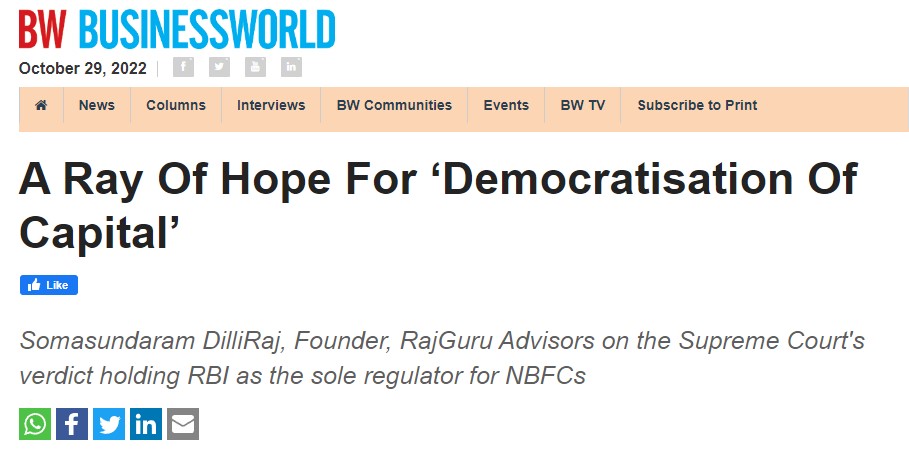

The Honorable Supreme Court Bench comprising Honorable Justice Hemant Gupta and Honorable Justice V.Ramasubramanian in its verdict of May 10, 2022, held RBI as the sole regulator for Non-Banking Financial Companies (NBFCs) registered with it. This is a ‘Ray of Hope’ providing the much-needed regulatory clarity that NBFCs are beyond the regulatory ambit of state governments. “The NBFC legal structure is here to stay” asserts Soamsudaram DilliRaj – Founder – RajGuru Advisors.
Many in the recent past discussed the possibility of extinction of NBFC structure with major ones converting into Banks and a few small falling by the wayside post the pandemic.
NBFCs serve a distinct purpose of their exemplary credit skills in meeting the funding requirements of the nonbankable in the nook & cranny of Bharat. Para 7.3 of the judgment records that “NBFCs which play a very vital role in contributing to the financial health of the country.”
NBFCs, especially Micro Finance Institutions (MFI s) who converted themselves into small finance banks cited access to low-cost Current Account Savings Account (CASA), etc as the rationale for conversion. Truth be told, the dominant logic was the Dual Regulation Risk Mitigant. This is not a mere Regulatory Risk but a political risk too. Andhra Pradesh (AP) MFI crisis ignited by the state’s MFI regulations in 2010, wiped out the AP portfolio of several NBFC MFIs. SKS Microfinance (BFIL) stood out by not joining the Corporate Debt Restructuring and ensured prompt repayment of INE 5,800 crores to the banking system without any incremental credit for 1 ½ year, rose up like a phoenix, and gained back the USD 1.5 billion market capitalization too. Corporate death was averted but the pain was acute. Financial inclusion was the real loser. 7.2 million MFI customers from the state were categorized as defaulters, got cut off from the mainstream, and thrown back to the money lenders.
Supreme Court is the final word and offers as much regulatory clarity as required. Therefore one of the pressure points for abdicating the NBFC structure is off the table.

The continued need for NBFC structure is advocated in a medley of merit-based arguments :
Avoid Concentration on credit delivery channels
The single most important lesson that ought to have been learned from the East Asian Crisis had nothing to do with ‘Cross Currency Exposure’ but avoiding the concentration of credit delivery channels.
We in India have gone back on our own wisdom. Indian financial system was replete with Development Financial institutions (DFIs) , Banks, and NBFCs, each one offsetting the weakness of the other.
DFIs turned into relics and NBFCs became ‘Children of the Lesser God’.
Resultantly all the credit risk was concentrated in the hands of Public Sector Banks (PSBs) and NPAs from infra/mega projects paralysed a few of them into Prompt Corrective Action.
The lack of “ mirror image refinance options ” compelled NBFCs to fund a 10-year housing loan or a 20-year Toll Road Project with 90 days of CPs.
Indian financial system is crying for a Development Financial Institution(DFI) and the Honorable Finance Minister has granted the same with a capital of INR 20,000 crores
Now it is time to leverage the NBFC structure to accomplish the national priority of financial inclusion.
NBFCs do what Banks ‘don’t want to do’ or “can’t do”
Bankers are adept at evaluating the Balance Sheet and determining the value of underlying security to take a credit call. When a Trucker walks in without a Balance sheet – how do you evaluate? That is what Sundaram Finance & Shriram Transport Finance have done successfully over decades. Also, the lean & fit cost structure of NBFCs makes the whole proposition viable despite the low ticket size
The vibrancy of the economy
NBFCs are a sign of a vibrant economy. That is why you have them in the US & UK and perhaps not in Sub-Saharan economies. Remember- it is Travelers who took over CitiBank.
Bankruptcy risk is structure agnostic
The common perception is that NBFCs are more prone to bankruptcy risk because of their structural disadvantage of funding constraints. But then for every DHFL, one can cite a Yes Bank.
Pooling of Resources
‘NBFCs only’ isn’t the argument but ‘NBFCs also’. The enormity of exclusion demands harnessing all possible funding options to bridge the gap. With instruments like Business Correspondence, Securitization, and Co -lending, NBFCs, and Banks can always pool their resources to achieve the amalgam of ‘Credit Delivery Skills’ of NBFCs and the ‘Funding Capability ’ of banks to usher in ‘Democratisation of Capital’ concludes Somasundaram DilliRaj – Founder – RajGuru Advisors.


Recent Comments